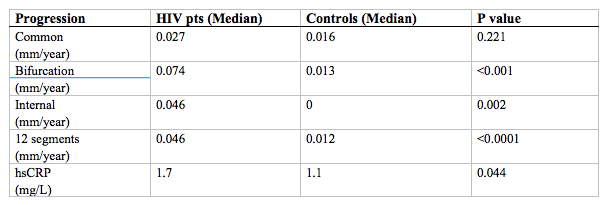 |
 |
 |
| |
Rapid Progression of Atherosclerosis at the Carotid Bifurcation Is Linked to Inflammation in HIV-infected Patients - "These data strongly suggest that inflammation contributes to the higher risk of atherosclerosis noted in HIV-infected persons."
|
| |
| |
Reported by Jules Levin
CROI 2010 Feb 16-19 SF
Priscilla Hsue*, P Hunt, A Schnell, V Selby, A Bolger, C Kalapus, J Martin, P Ganz, and S Deeks
Univ of California, San Francisco, US

ABSTRACT
Background: Shear stress gradients and inflammation in arterial bifurcation regions are implicated in the development of atherosclerosis. In order to more fully define the role of inflammation versus other factors in the pathogenesis of HIV-associated atherosclerosis, we measured carotid intima-media thickness (IMT) in the common carotid vs the bifurcation region over time in a cohort of HIV-infected and uninfected persons.
Methods: We measured the annualized rates of progression in 12 preselected segments of the carotid artery including the common carotid, the bifurcation region, and the internal carotid artery in an unselected cohort of HIV patients and uninfected controls.
Results: A total of 285 HIV-infected persons and 40 controls were studied. The median age was 46 years (IQR 41 to 52); 89% were male. The median duration of follow-up was 2.2 years. Overall, IMT progression as assessed using 12 segments was significantly higher in HIV patients as compared to controls (see Table); this effect remained significant after adjustment for traditional risk factors. The effect of HIV was strongest in the bifurcation (P <0.001) and internal carotid regions (P =0.002), but absent in the common carotid (P =0.221). In HIV patients, IMT progression was most marked in the bifurcation region as compared to the common carotid (P <0.0001) or internal carotid (P =0.0007). IMT progression among the treated and suppressed HIV patients was also higher than controls (P =0.001). After adjustment for both traditional risk factors and HIV characteristics, hsCRP was independently associated with progression in the bifurcation region, while traditional risk factors (age, smoking) were more strongly associated with internal carotid progression.
Conclusions: Atherosclerosis progresses preferentially in the bifurcation region in HIV-infected individuals. While traditional risk factors predict internal carotid progression, inflammation as assessed by hsCRP is linked to progression in the bifurcation. These data strongly suggest that inflammation contributes to the higher risk of atherosclerosis noted in HIV-infected persons. Future studies of subclinical atherosclerosis in HIV-infected individuals should focus on the bifurcation region as a site of marked disease predilection.









RESULTS











|
| |
|
 |
 |
|
|